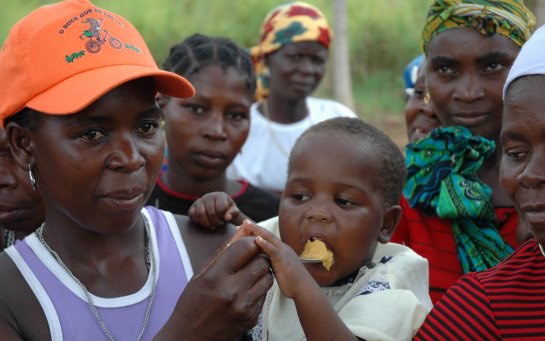Development projects set out to better understand and find ways to improve outcomes for people in less developed countries, whether they focus on agriculture, schooling, improving health, or other types of technology adoption. While a great deal of time and attention is spent designing and implementing interventions, surprisingly little is known about how long effects from development projects last or, indeed, much about what happens after projects end at all.
Our recently published paper, “Vitamin A Intakes Remain Higher Among Intervention Participants Three Years After a Biofortification Intervention in Mozambique,” returned to villages that were included in Harvest Plus‘s Reaching End Users (REU) project three years after the project ended. The REU introduced biofortified orange sweet potatoes to households to grow, consume, and sell, and was successful in increasing vitamin A intake among targeted children and their mothers. The project ended in 2009 and no funding could be found to continue; as such, vine multiplication in the province declined dramatically. The gap in support gave us the chance to see what really lasted, based on what the communities learned and carried forward truly on their own.
We learned that:
- Children between the ages of 6 and 35 months within participant villages had higher intakes than children in control villages by about half the U.S. recommended daily allowance of vitamin A.
- These children had not yet been born when the project ended, so clearly both messages about maintaining the growth of orange sweet potatoes and that they are healthy for children resonated. In fact, we found some people obtained sweet potatoes from their neighbors for kids when they were no longer growing them on their own.
- Since villages in the control group received vines but no extension support, clearly teaching people to grow the particular crop (or varieties) was critical to maintaining successful consumption among young children.
- There are clearly implications for cost effectiveness. When we initially measured cost per beneficiary, we only considered the beneficiaries during the project. How can projects account for benefits that come after it concludes, to those beyond the original scope? The next generation in a community to benefit from an intervention simply cannot be defined at the end of a project, but their potential to benefit is quite real. But not all projects may be successful in inducing benefits among further beneficiaries, meaning future measurement is necessary to better understand what works and what might not.
There is much we—as researchers, donors, policymakers, and other stakeholders—can learn about the work we do by following up on successful projects in this manner. Not only can we see what impacts lasted, how a community might still be benefiting, and how those benefits may have grown, but we can also learn lessons to improve our work going forward.
Alan de Brauw is a Senior Research Fellow with IFPRI’s Markets, Trade, and Institutions Division. This post also appears on the CGIAR Research Program on Agriculture for Nutrition and Health (A4NH) blog.
Learn more from Harvest Plus about the findings from this paper.
The primary study was supported by HarvestPlus and the International Center for Tropical
Agriculture (CIAT). The 2012 round of data collection and analysis time was partially supported
by the European Commission.







